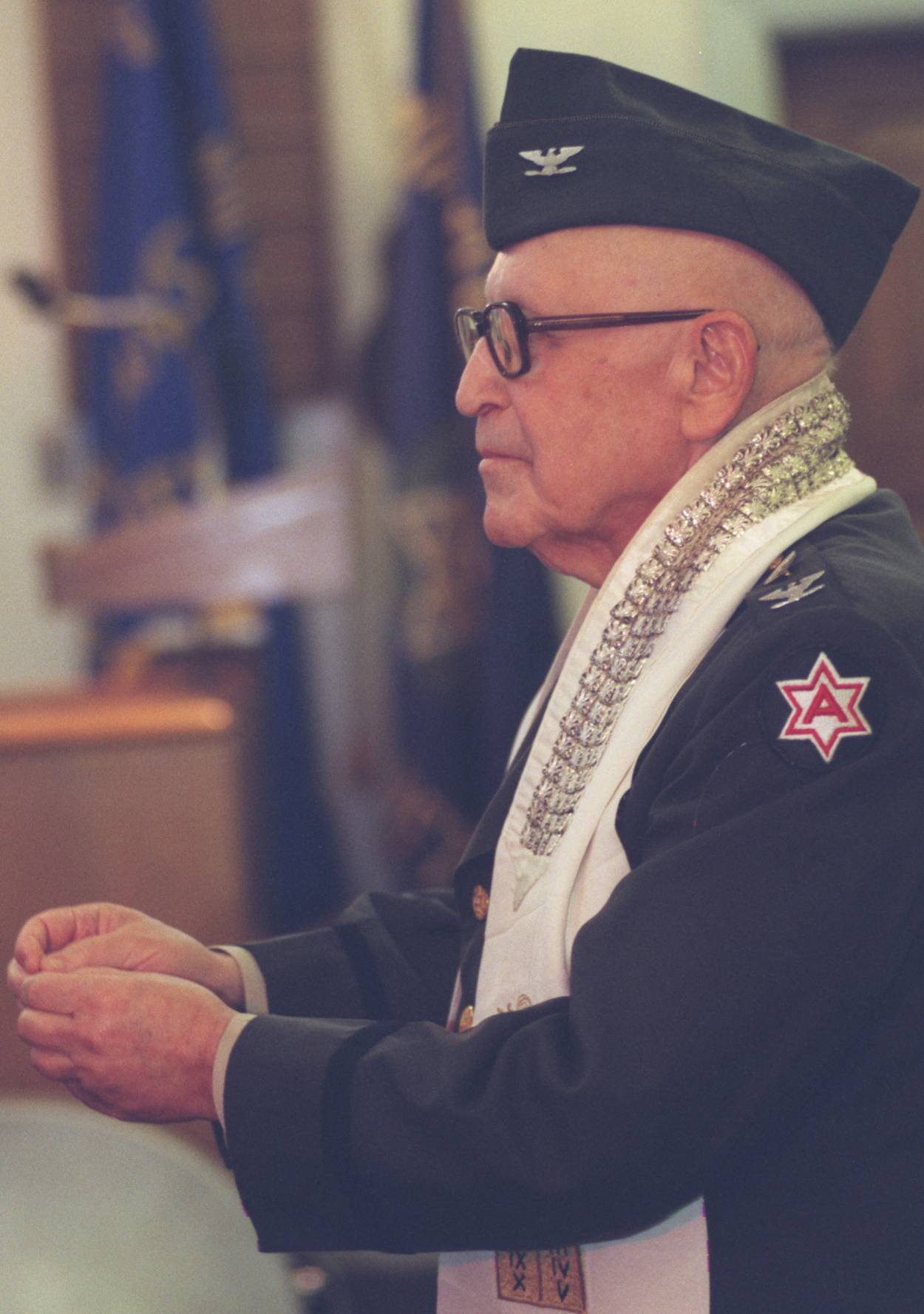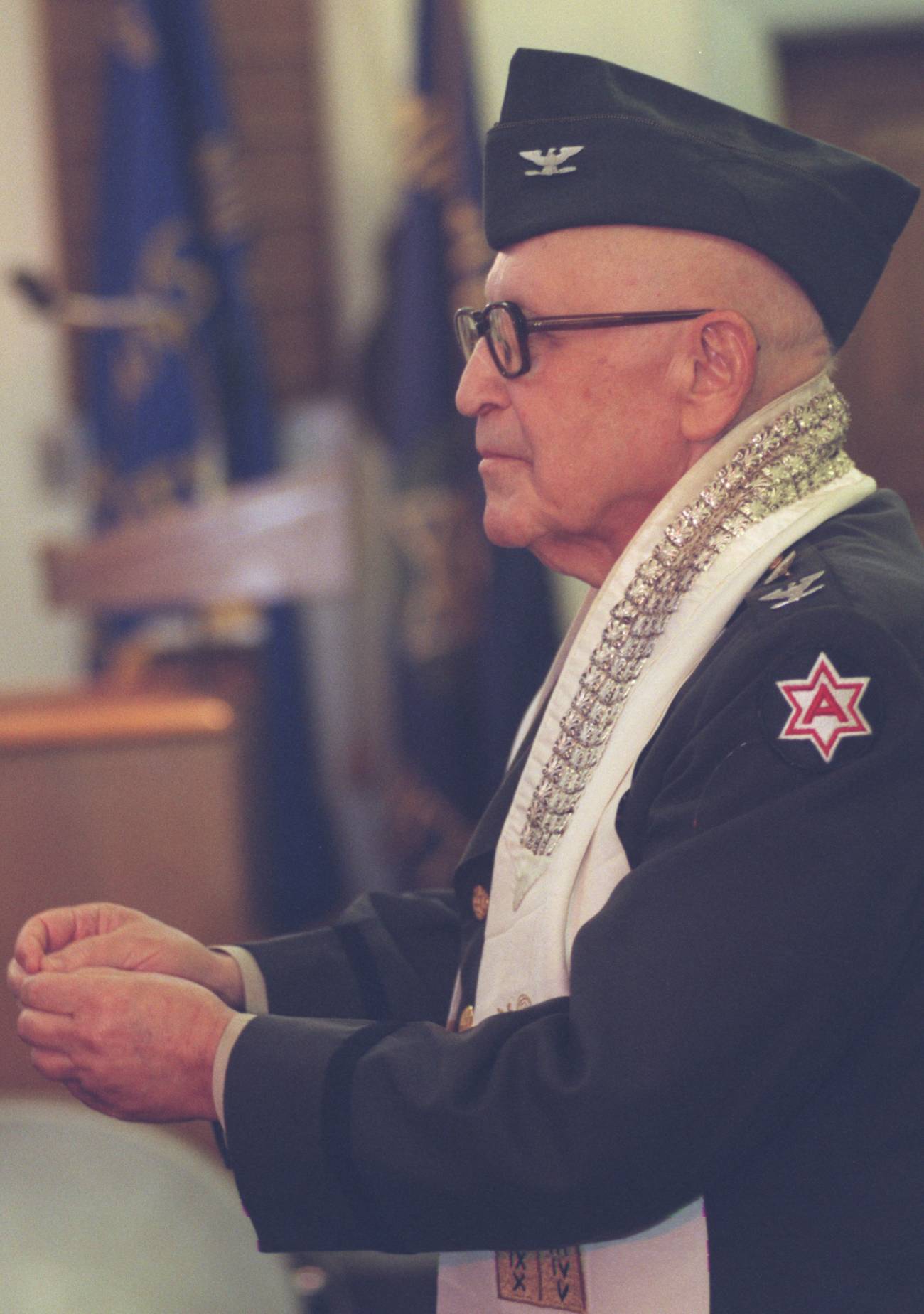What a Difference a ‘J’ Makes
The history of religious identification in military insignia—and how Jewish symbols evolved




The Dupont Circle neighborhood of Washington, D.C.—where I lived during the academic year before COVID-19 sent me back to New York for the duration—is home to all sorts of cultural institutions, from embassies and think tanks to fraternal organizations. My leafy block alone houses the German Historical Institute and the General Grand Chapter, Order of the Eastern Star, whose limestone structure is very grand, indeed. Just a stone’s throw away stands the handsome, if far more subdued, red brick building of the National Museum of American Jewish Military History. For years, I’d pass by and wonder what was inside.
When, at long last, I had the opportunity to step into the museum and visit its core exhibition, what caught my eye was nothing spectacular in the way of most military museum holdings—no downed airplane parts, boulder-size cannonballs, or bloodstained flags—but two decidedly humble and well-worn pieces of tin: dog tags belonging to WWII servicemen Eli Heimberg and Abraham Penn, on which were stamped their names, blood types, rank, and an “H.” An “H”?
That was no typo. An “H” stood for “Hebrew,” which was the way “J-for-Jewish” servicemen in the United States Armed Forces were officially designated since the early 20th century, when the practice of having military personnel wear some form of identification on their person became de rigueur.
The difference between an “H” and a “J” might not seem like much, but on this little detail hangs a whopper of a tale: the process by which the United States came to reckon with and, eventually, to acknowledge the diversity of those who served in the armed services, or what historian Ronit Stahl, the author of Enlisting Faith, wryly calls “dog tag equity.”
Those of us who, hearing all about the Judeo-Christian heritage in the classroom and on the campaign trail and take comfort from Judaism’s place within the big tent of American faith traditions, might be surprised, even discomfited, to learn that it wasn’t until 1954 that the United States saw fit to imprint a “J” for Jewish on the dog tags of American Jewish servicemen and women.
Replacing the “H” with a “J” took some doing and much special pleading on the part of American Jewish lay and rabbinic leaders who, during WWII, explains Stahl, viewed the “H” as “archaic,” an outmoded and racialized form of identification. Like most of their co-religionists in interwar America, they preferred to characterize members of the tribe as a religious entity, a faith tradition, just like Catholics and Protestants. If the former bore a “C” and the latter a “P” on their respective dog tags, surely, reasoned the rabbis, a “J” was warranted for military personnel of the Jewish faith. They had a point, but it took a while to sink in.
No sooner did word of a possible change begin to circulate than religious groups who fell outside the boundaries of the Judeo-Christian template—among them Buddhists (“B”) and Eastern Orthodox (“O”)—bid for official recognition. The military dug in its heels, fearful, as the Armed Forces Chaplains Board put it in 1948, lest “every minute fraction of a percent claiming distinct worship, or even simply belief in God, would request their own symbol.” And if that wasn’t worrisome enough, a threat to both national unity and bureaucratic stability, a “B” for “Buddhist,” say, could just as easily be read as a “B” for “Baptist,” or a “B” for “Believer,” or, “under duress of battle … misread as blood type,” or so it was alleged.
Perhaps, the military suggested, an “X” might do for those whose faith didn’t accord with the three “principal” religions. Not surprisingly, that idea didn’t go over too well with those on the receiving end of an “X,” prompting their representatives to ramp up their campaign for a letter all their own.
Whether they wore down the authorities or the latter saw the light and belatedly recognized the religious diversity of those within its ranks, is hard to say. But one thing was increasingly obvious: Amid the postwar revival of religious expression and church-going, change was afoot. In July 1955, reported The New York Times, the Army “declared that every soldier may now have his particular religious denomination stamped on his identification tag.”
The alphabet wasn’t the only marker to confound and even vex the military powers-that-be. Once Jewish chaplains came on the scene during WWI, how—or whether—to differentiate them from their Christian counterparts turned out to be quite the bureaucratic and visual challenge. At the time, no distinctive insignia was at hand. Jewish chaplains were expected to wear a cross on their collar as did their Protestant and Catholic colleagues. New to the job and few in number—by the time WWI came to an end, there were only eight of them in the entire fighting force—they were not inclined at first to kick up a fuss by insisting on what one of their number called expressions of “sectarian theology.”
In a February 1918 interview with the American Hebrew, David Goldberg of Corsicana, Texas, the first Jewish chaplain appointed to the Navy, maintained that amid the “cosmopolitan complexion of the naval body,” where there were Christians “of many varieties,” as well as Jews and Confucians, “sectarian theology would be more of a hindrance than a fostering spirit of unity.” Jewish chaplains were there to serve everyone.
While Chaplain Goldberg maintained his faith in the “common bond” among servicemen, he would soon change his tune when it came to wearing a cross on his collar. He refused. Instead, he sought permission from the Bureau of Navigation, the naval office in charge of personnel, to minister to his flock while wearing the more neutral insignia of a shepherd’s crook. Chaplain Goldberg’s request was denied, but not before it was suggested that he come up with another option.
The newly constituted Jewish Welfare Board was at the ready. After much internal to-ing and fro-ing and behind-the-scenes lobbying of various divisions of the War Department, including the offices of the Chief of Staff and the Quartermaster General, a number of suggestions came to the fore. A menorah was one, the six-pointed Star of David another, and the Ten Commandments a third. What carried the day, soon to ornament the collars of Jewish chaplains (and during WWII, their helmets as well) was a miniaturized version of the twin tablets, each panel bearing a set of Roman numerals. A Star of David perched atop the tablets, gilding the lily.
Not everyone welcomed the visibly distinctive insignia of the Jewish chaplain. Some Protestants, reported the American Israelite in November 1918, bristled at the notion that the Jews had an “emblem peculiar to themselves,” anxious lest they use the war “as a time for their own denominational propaganda work.” A number of American Jews, in turn, bristled at the use of Roman numerals rather than the letters of the Hebrew alphabet to designate the commandments. If, as representatives of the Jewish community claimed, the Ten Commandments was to the Jews (aka the “Hebrews”), what the cross was to Christians, why stop short of heralding it as a Jewish symbol, through and through?
Fear of desecration, of exposing the sacred Hebrew letters to the most frightful of wartime conditions, was one response; the difficulty of procuring Hebrew letters another. Left unsaid but implicit all the same: By WWI, American visual culture, which prized the Ten Commandments, commonly depicted them with Roman numerals, not Hebrew letters. (By then, the “Tablets of the Law” had become as much an American phenomenon as a Jewish one, but that’s another story.)
Though quelled at the time and for several decades thereafter, concern over the nomenclature by which the Ten Commandments was identified repeatedly surfaced. Writing more than 50 years later, in 1972, Rabbi Judah Nadich, General Eisenhower’s adviser on Jewish affairs, called the concern a “perennial” one, while Rabbi Aryeh Lev, director of the National Jewish Welfare Board’s Commission on Jewish Chaplaincy, across whose desk passed any number of suggestions—among them, replacing both the Hebrew letters and the Roman numerals with “short straight horizontal lines”—described it as “really an interesting matter.”
It would take another decade—a total of 65 years—before Hebrew lettering finally made its way onto the Jewish chaplain’s Ten Commandments insignia. In 1983, it became official.
The substitution of a “J” for an “H” and of the Hebrew alphabet for Roman numerals may not appear on anyone’s list of triumphant historical moments or victories. Perhaps they should. Gestures of inclusion and public recognition, these two visual declarations not only stabilized American Jewry’s footing, but also bolstered its confidence, its self-assertion, as a minority culture. By my reckoning, that qualifies as a victory.
Jenna Weissman Joselit, the Charles E. Smith Professor of Judaic Studies & Professor of History at the George Washington University, is currently at work on a biography of Mordecai M. Kaplan.